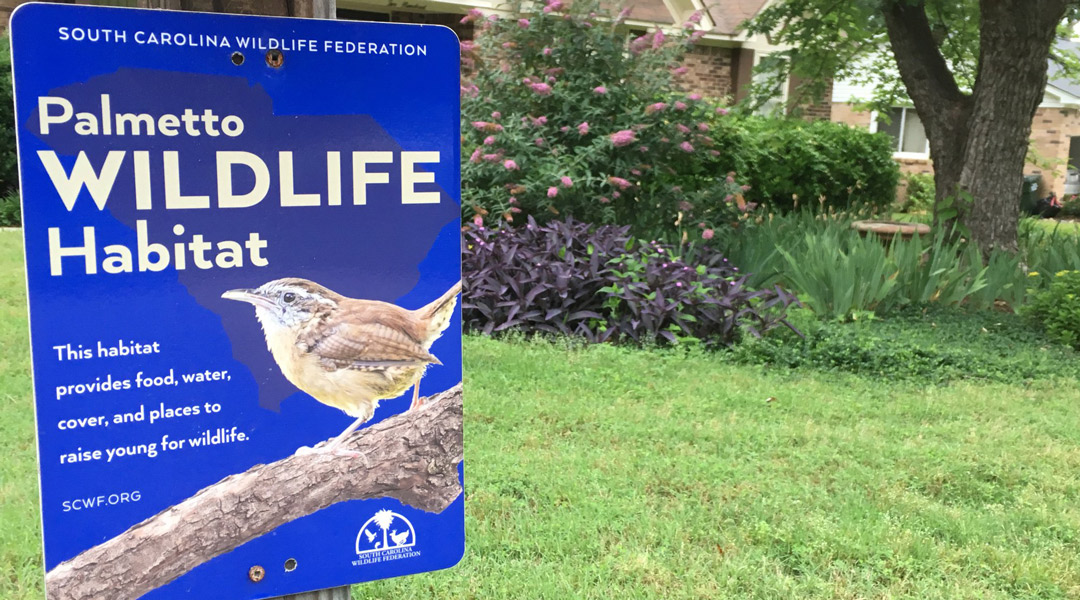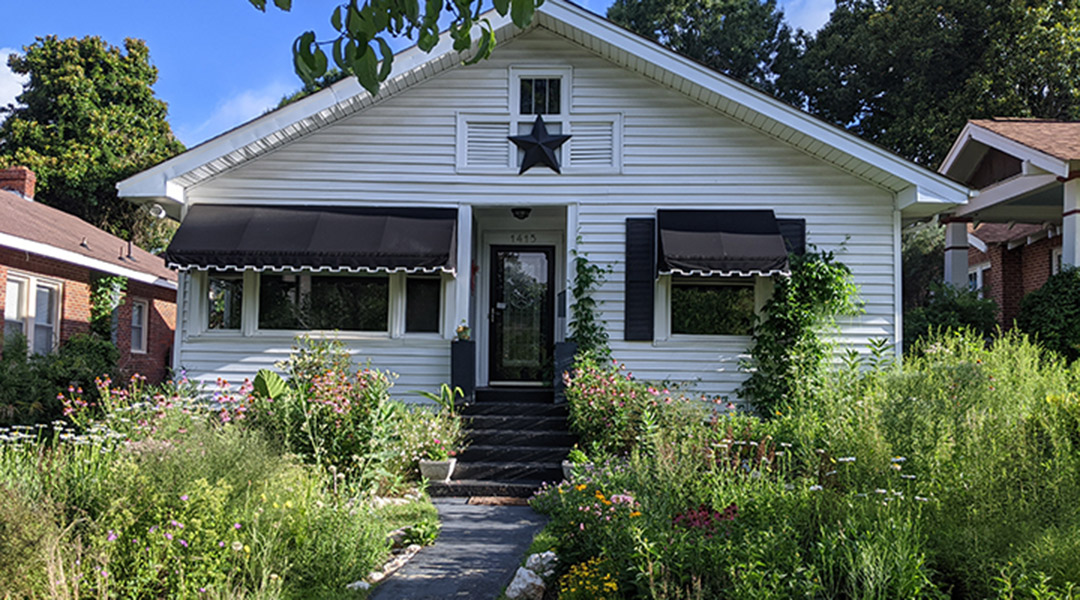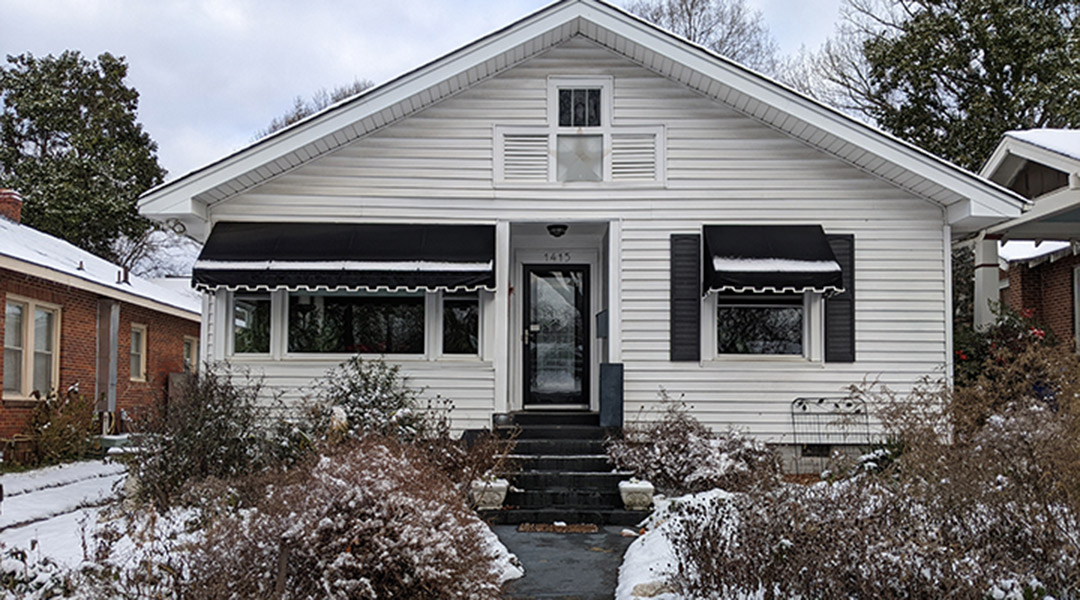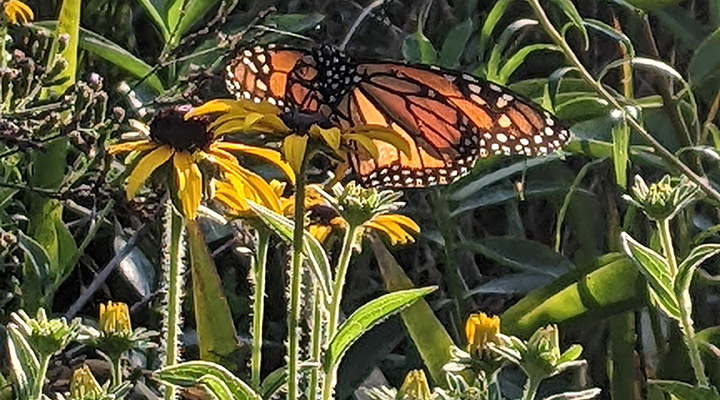A Palmetto Wildlife Habitat in a lawn certified by the South Carolina Wildlife Federation (Photo courtesy of Sara Green/Carolina News & Reporter)
Terry Wolfer returned home from work and checked his mail one April afternoon last year and was alarmed to find a Notice of Violation and Correction Order from the Columbia Police Department.
Wolfer, a social work professor at USC, was cultivating a natural yard that provided a habitat for Columbia’s wildlife. But Columbia’s nuisance ordinance did not view it that way. The citation in his mailbox required that he cut down his lawn.
“I think most Americans are so accustomed to mowed turf grass that they don’t know what to do with something else when it’s higher … like tall native grasses,” Wolfer said. “So many of the plants in my yard grow two to four feet tall, and a few of them are five feet tall. … So that looks a lot different than a trimmed hedge or an annual flower garden.”’
Creating a plan
Revisions to the city of Columbia’s nuisance ordinance that allow residents to grow natural, wildlife lawns moved to City Council on Oct. 22 for review. Wolfer said he is pleased with the ordinance’s progress.
Wolfer talked with friends and discovered some of them also had received citations for their natural gardens and lawns. Wolfer is now among an increasingly vocal community that’s pushing back against the nuisance ordinance that they believe is wrongly blocking homeowners from providing for wildlife that’s native to South Carolina.
Wolfer said he would like to see a plan that would allow Columbia residents to cultivate a lawn that provides a habitat for wildlife.
He created a presentation for the Midlands Chapter of the South Carolina Native Plant Society detailing a biodiversity “crisis” in Columbia. He said uniform turf lawns cannot create biodiversity in a community.
Trish Jerman, a board member of the Midlands Chapter of the South Carolina Native Plant Society, agrees.
“A lawn … is absolutely a wasteland, a desert when it comes to feeding wildlife, and so you don’t want that,” Jerman said.
Wolfer said he was looking to propose a native plant ordinance that would rewrite the nuisance ordinance.
Columbia’s nuisance ordinance provides that if the chief of police or a housing officer thinks a yard presents a potential hazard to public safety, then they can issue a “notice to clean up lot or premises.” The notice orders the resident to clear the lot of “uncultivated vegetable growth or briars, brush, grass, weeds, litter, offal, refuse, rubbish, trash, stagnant water, inoperative or unregistered motor vehicles, or other matter deleterious to good health and public sanitation.” The ordinance does not define the cost of a fine or penalty, but says those who fail to comply will “be guilty of a misdemeanor, punishable, upon conviction.”
Jerman, along with Sarah Green, executive director of the South Carolina Wildlife Federation, and Bailey Slice Parker, executive director of Gill’s Creek Watershed Association, created a proposal based on Wolfer’s presentation. It included revising the nuisance ordinance and retraining housing officers to recognize intentional growth and cues for care.
The group presented it to the Columbia City Council on Aug. 7. But Jerman said the city was looking for a simpler solution.
“The city wants a fairly black and white, easy way for their code inspectors to be able to look at a property and say, ‘Yes, this is gardening for wildlife,’ as opposed to, ‘This is somebody who’s really messy,’” Jerman said.
Jerman, Green and Slice-Parker worked with the Health, Social and Environmental Affairs Committee, headed by Councilwoman Aditi Bussells, to rework and review the submitted proposal.
The solution they found was a third-party certification program. Organizations such as The South Carolina Wildlife Federation and Gills Creek Watershed Association have programs in which they certify residents who intentionally create yards that are beneficial to their environment. This proposal would allow these organizations to keep lists of certified residents and send them to the city, to prevent those residents from receiving a citation.
Using existing programs
The Gills Creek Watershed Association and The South Carolina Wildlife Federation are two of the organizations involved in certifying residents with lawns benefiting their environments.
The Gills Creek Watershed Association certifies gardens through its Watershed Champion Certification program. The program requires three steps: know the destination of rainfall on your land, reduce contaminants in runoff and enrich the ecosystem.
The South Carolina Wildlife Federation has the Gardening for Wildlife program which requires four habitat elements: food, water, cover and places to raise young. It encourages the use of native plants.
Jerman said the city encourages businesses to plant native trees, but the ordinance hasn’t shown the same acceptance of native plants.
“On the one hand, you got this really lovely language, and then on the other hand, you’ve got the nuisance ordinance that says ‘Chop everything down. Don’t let anything grow taller than 12 inches,’” Jerman said.
The ordinance does not state a maximum height that yards are allowed to grow.
The Nuisance Ordinance
Wolfer grew up in Nebraska and was inspired by his love of the big open plains to cultivate a natural yard, one that was not a product of turf and shrubbery. He wanted to plant grasses and wildflowers native to South Carolina to reflect the region’s natural savannah landscape and respect the land’s history.
“My front yard doesn’t look like a wildlife meadow. I plant in clumps,” Wolfer said. “But I think I have about four dozen species in the front yard, different ones blooming at different times of the year. It’s just a lot of fun to watch. It’s just a very lively space.”
Wolfer said, after receiving the citation, he trimmed the edges of his lawn and cleared any excess weeds. Then he called the code enforcement officer back and explained the intentional growth in his lawn. He said the officer did not then penalize him.
Savannah Jordan, habitat education manager at the South Carolina Wildlife Federation, said some lawns are a nuisance and these codes are here for a reason. Residents with unruly lawns make for bad neighbors, she said.
Biodiverse yards require many different types of plants that are cultivated in a way that most people don’t expect. It generally means allowing seed heads to remain, letting plants die out and then return, and having a yard that appears dead in the winter. Jerman said some people are thrown by the unconventionality of the yards.
“It’s not going to be a field of pansies,” Jerman said. “It’s mostly natives, and it’s going to be a mix of things, because ideally when you’re gardening for wildlife, you want something there that’s going to serve wildlife through all the seasons.”
Jordan said it doesn’t take a lot of effort to make a difference and city ordinances should make room for Columbia residents who want to improve their community’s ecosystem.
“Even just having a small area of your yard designated to wildlife, like putting in a small pollinator garden,” Jordan said. “No, it doesn’t have to be your whole yard, but just designating a portion of it is going to make a big difference.”
Terry Wolfer’s natural, wildlife habitat lawn at 1415 Victoria Street during the summer months (Photo courtesy of Terry Wolfer/Carolina News & Reporter)
Wolfer’s natural, wildlife habitat lawn during the winter months (Photo courtesy of Terry Wolfer/Carolina News & Reporter)
A monarch butterfly sits on a flower in Wolfer’s yard. (Photo courtesy of Terry Wolfer/Carolina News & Reporter)
Caterpillars crawl on leaves in Wolfer’s yard. (Photo courtesy of Terry Wolfer/Carolina News & Reporter)






